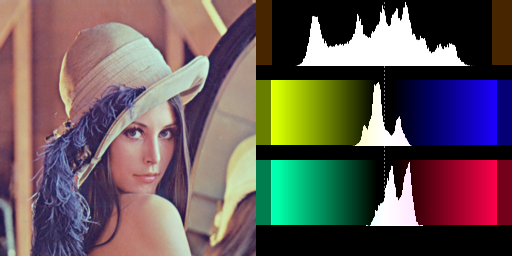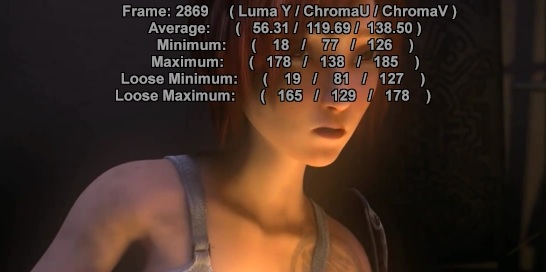ColorYUV
ColorYUV has many different methods of changing the color and luminance of your images. Gain, offset, gamma and contrast can be set independently on each channel. Also included are two 'auto' modes, an analysis function and a color gamut generator.
All settings for this filter are optional. All values are defaulting to "0" or false.
Contents |
Syntax and Parameters
ColorYUV(clip [,
float gain_y, float off_y, float gamma_y, float cont_y,
float gain_u, float off_u, float gamma_u, float cont_u,
float gain_v, float off_v, float gamma_v, float cont_v,
string levels, string opt, bool showyuv, bool analyze,
bool autowhite, bool autogain, bool conditional ] )
- clip =
- Input clip
- float gain_y = 0
- float gain_u = 0
- float gain_v = 0
- A multiplier for the Y, U or V value.
- If gain_y = k, then Y becomes Y · (k/256 + 1) – for example:
gain_x → multiplier -256 (-256 / 256) + 1 0.0 (no output) -128 (-128 / 256) + 1 0.5 (darker) 0 (0 / 256) + 1 1.0 (no change) 256 (256 / 256) + 1 2.0 (brighter) 512 (512 / 256) + 1 3.0
- gain_x is valid down to -256, where a gain of 0.0 is applied.
- Although it is possible, it doesn't make sense to apply this setting to the chroma of the signal.
- In order to confuse you, in the filter Tweak this setting is called contrast.
- float off_y = 0
- float off_u = 0
- float off_v = 0
- Adds an offset to the luma or chroma values.
- An off_x of 16 will add 16 to all pixel values.
- An off_x of -32 will subtract 32 from all pixel values.
- Adds an offset to the luma or chroma values.
- float gamma_y = 0
- float gamma_u = 0
- float gamma_v = 0
- Adjusts gamma of the specified channel as X(1/g) where g=(gamma_x+256)/256 – for example:
gamma_x → gamma -256 (-256 / 256) + 1 0.01 -128 (-128 / 256) + 1 0.5 (darker) 0 (0 / 256) + 1 1.0 (no change) 256 (256 / 256) + 1 2.0 (lighter) 512 (512 / 256) + 1 3.0
- gamma_x is valid down to -256, where a minimal gamma of 0.01 is applied (gamma cannot be zero)
- Note: gamma for chroma is not implemented (gamma_u and gamma_v are dummy parameters).
- float cont_y = 0
- float cont_u = 0
- float cont_v = 0
- Like gain_X, a multiplier for the value, but stretches or shrinks the signal from the center (128).
- This is most useful for the chroma components, where it translates to saturation.
- If cont_y = k, then Y becomes (Y-128) · k/256 + 128 – for example:
cont_x → contrast -256 (-256 / 256) + 1 0.0 (zero contrast) -128 (-128 / 256) + 1 0.5 (less contrast) 0 (0 / 256) + 1 1.0 (no change) 256 (256 / 256) + 1 2.0 (more contrast) 512 (512 / 256) + 1 3.0
- cont_x is valid down to -256, where the signal is set to 128.
- Although it is possible, it doesn't make sense to apply this setting to the luma of the signal.
- string levels = ""
- Can be "TV->PC", "PC->TV" or nothing (default)
- This option can convert between "TV" range (black=16, white=235) and "Full" or "PC" range (black=0, white=255).
- If levels="TV->PC", a 16-235→0-255 (contrast increasing) conversion is made
- If levels="PC->TV", a 0-255→16-235 (contrast decreasing) conversion is made
- By default, no conversion is made
- string opt = ""
- Can be either "coring" or "" (nothing, default setting).
- Specifying "coring" will clip your YUV values to the "TV" range (16-235). Otherwise values outside that range will be accepted.
- bool showyuv = false
- If true, this option will overwrite your image with a new 448x448 image showing all chroma values along the two axes. This can be useful if you need to adjust the color of your image, but need to know how the colors are arranged. At the top left of the image, the chroma values are '16'. At the right side of the image, U is at maximum. At the bottom of the screen V is at its maximum. In the middle both chroma is 128 (or grey). See example image below.
- bool analyze = false
- If true, ColorYUV will print color channel statistics on the screen (see example below)
- There is an Average for all channels.
- There are Minimum and Maximum values for all channels.
- There is Loose Minimum and Loose Maximum which ignore the brightest and darkest 0.4% (1/256) pixels.
- If true, ColorYUV will print color channel statistics on the screen (see example below)
- bool autowhite = false
- If true, this option will use the information from the analyzer, and attempt to center the color offsets. If you have recorded some material, where the colors are shifted toward one color, this filter may help. But be careful - it isn't very intelligent - if your material is a clear blue sky, autowhite will make it completely grey! This option overrides off_u and off_v.
- bool autogain = false
- If true, this option will use the information from the analyzer, and attempt to create as good contrast as possible. That means, it will scale up the Y (luma) values to match the minimum and maximum values. This will make it act like an "autogain" setting on cameras, amplifying dark scenes very much, while leaving scenes with good contrast alone. Some places this is also referred to as "autolevels".
- bool conditional = false
- See the Conditional Variables section for an overview of the conditional variables and their use with ColorYUV. If false (the default), ColorYUV will ignore any conditional variables.
Parameter Scaling
The quantities saturation, contrast and brightness (as in Tweak for example) are connected with quantities in this filter by the following equations:
- cont_u = cont_v = (sat-1) * 256
- gain_y = (cont-1) * 256
- off_y = bright
A saturation of 0.8 gives for example: cont_u = cont_v = -0.2 * 256 = -51.2.
Note that in Tweak your YUV values will always be clipped to valid TV-ranges, but here you have to specify opt="coring".
You can add a simple user function to translate from familiar "Tweak-like" units to ColorYUV units:
ColorYUV(gain_y=256, cont_u=51.2, cont_v=-51.2) ## the next statement is equivalent to the previous one: ColorYUV(gain_y=f2c(2.0), cont_u=f2c(1.2), cont_v=f2c(0.8)) ## scale "Tweak-like" arguments for ColorYUV function f2c(float f) { return (f - 1.0) * 256.0 }
Conditional Variables
The global variables "coloryuv_xxx" with xxx = gain_y, gain_u, gain_v, bright_y, bright_u, bright_v, gamma_y, contrast_y, contrast_u or contrast_v are read each frame, and applied. It is possible to modify these variables using FrameEvaluate or ConditionalReader.
For example:
coloryuvoffset.txt:
Type float Default 0.0 I 25 50 0.0 255.0 R 75 225 128.0 I 250 275 255.0 0.0
the script:
Colorbars(512,256).ConvertToYV12.Trim(0,299)
ColorYUV(cont_y=10, conditional=true)
ConditionalReader("coloryuvoffset.txt", "coloryuv_gain_y", false)
ShowFrameNumber()
So up to frame 25 gain_y is equal to the default (which is 0.0), for frame 25 up to 50 the gain_y is increased from 0.0 to 255.0, etc ...
There are more examples of conditional modification at the ConditionalReader page.
Examples
- Adjust Y (luma) gamma and offset (brightness), while increasing chroma U (yellow-blue) offset (away from yellow and toward blue)
ColorYUV(gamma_y=128, off_y=-16, off_u=5)
- autogain and autowhite: recovers visibility on "very bad" recordings:
ColorYUV(autogain=true, autowhite=true)
- showyuv: show all colors in the YUV space. Requires a YUV clip as input. Returns a YV12, 448x448 clip with source frame rate, duration and audio.
- Note, not all colors are convertible to RGB - see this discussion on doom9.
- U values run 16-239, left to right, and V values run from 16-239, top to bottom. Frame 0 luma is 16, frame 1 luma is 17 and so on.
ColorYUV(showyuv=true)
- Adjusting off_u and off_v to remove color cast (reduce yellow and magenta tints):
ImageSource("Lenna.png") BicubicResize(Width/2, Height/2) ColorYUV(off_u=+6, off_v=-23) Histogram("levels")
- Demonstrating analyze output
FFmpegSource2("sintel.mp4") BicubicResize(546, 272) ColorYUV(analyze=true)
Changelog
| v2.6 | Added conditional option |



